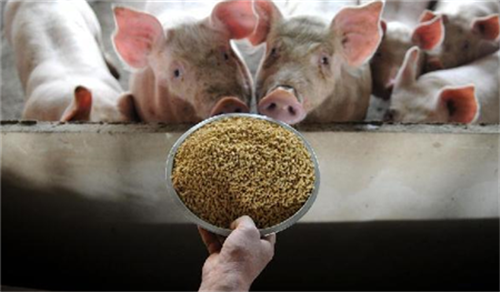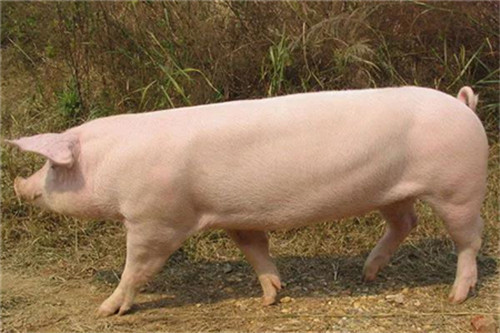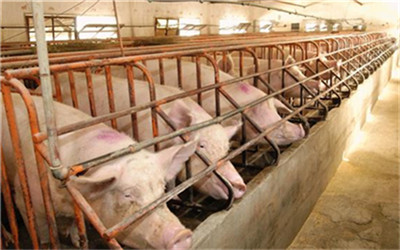Pig farm to reduce feed mildew, do a good job of these eight practical measures
The pig house has high environmental temperature and high humidity, which is very suitable for the growth of molds. The period of validity of the feed preserved at room temperature is reduced. In the process of storage and feeding, the feed is easy to mildew and deteriorate if it is not managed properly.
After eating moldy feed by mistake, pigs often lead to a series of problems, such as obstruction of growth and development, vomiting, rectal prolapse, infertility, false estrus, abortion and so on. Mycotoxins and their metabolites in feed will also remain in animal products, affecting the quality of animal products and threatening human health. How to reduce feed mildew in pig farms is important and urgent in southern pig farms, especially in summer climate.
one
Hardware optimization of warehouse and silo
The main results are as follows: (1) the pig farm feed warehouse should be built in the high dry, ventilated and cool place. The floor of the feed warehouse must be moistureproof, and the walls of conditional pig farms can also be moistureproof. In the area where fodder is stacked, it is best to lay a 10-20 cm keel on the hardened ground, covered with synthetic board or wood, as a secondary moistureproof treatment. In addition, the roof of the warehouse should also be insulated and moistureproof. At the same time, we must ensure that the warehouse is well ventilated.
(2) the silo of the automatic material line is installed in a cool and dry place, or a sunshade is built above the silo. Ensure that the silo is dry, ventilated and cool to avoid internal self-condensation or high temperature in the silo, resulting in the growth and reproduction of mold in the feed.
two
Scientific specification for purchase and preservation of feed
(1) Pig farms should purchase high quality feed produced by big brand companies. In order to reduce feed costs, some small feed producers may use by-products such as distiller's grains (DDG) and alternative feed materials, which are often contaminated with high levels of mycotoxins, thus reducing feed quality and greatly increasing the risk of feed mildew in subsequent processes.
(2) strengthen the monitoring of incoming raw materials and finished feed, and strictly control the moisture of feed raw materials. Pig farms should purchase high-quality feed raw materials, the crushing rate of raw materials should be low, the moisture content of corn should not exceed 15%, the moisture content of wheat bran should not exceed 13%, the moisture content of soybean meal should not exceed 12%, and for finished pellets, its moisture should not exceed 12.5%.
(3) if the raw materials and finished feed entering the pig farm are drenched in the rain, exposed to the sun or damaged packaging, they should be clearly marked or returned directly, and the relevant person in charge of the pig farm should put forward the relevant requirements for the transportation of feed to the feed supplier in advance.
(4) in the pig farm with self-made feed, the feed is now processed, and the feed should be fully cooled after crushing, and then bagged when the temperature drops to room temperature; otherwise, it is easy to cause moisture condensation and lead to the deterioration of the powder. The processed feed should not be stored for more than 2 days. Conditional pig farms can consider adding mold inhibitors to the feed to prevent the formation of mold.
(5) the pig farm feed purchase should be carried out in batches and planned in advance according to the pig farm feed consumption. In principle, the pig farm only accepts fresh feed within 7 days of the production date, and the stock feed is used up as soon as possible during the shelf life. In the process of feed storage, it is necessary to check and turn it regularly, and it is strictly forbidden to use expired, agglomerated and moldy feed. When using feed in pig farms, priority feeding and first-come-first-served principles should be followed.
(6) the feed stacking is scientific and reasonable, and there is a gap between the stacked feed stacks, which is not against the wall, which is convenient for ventilation and statistical distribution.

three
Reasonable selection of material line, dispenser and trough
In order to reduce feed residues in feed lines, dispensers and troughs, pig farm investors are required to purchase high-quality facilities and equipment. Jiaolong and racing plate in the material line must be matched with the material pipe to avoid excessive residue of feed in the dead corner of the material pipe and mildew. The inner wall of the dispenser is smooth, there is no convex and concave ring lining structure, and the inner wall of the material trough is smooth, which reduces the probability that the feed remains in the inner wall and avoids causing the residual material to mildew.
four
Timely cleaning of silo, material line and teaching trough
In the hot and humid summer season in the south, pig farm managers should check and clean the warehouse more than twice a week, find abnormal conditions such as broken feed packaging, agglomeration, mildew and so on, and deal with them in time to avoid deteriorating feed entering the pig house.
(1) for the pig farm with automatic feed line, strictly according to the feed intake and quantity of pigs fed, budget the daily feed consumption, and add feed to the silo in a planned way to ensure that the feed is clean and fresh. The feed in the silo is empty more than twice a week. At the same time, pay attention to thoroughly clean the silo to avoid mildew accumulation. If the powder is fed, it is necessary to take the initiative to clean the silo and feed the hopper automatically to avoid clogging the material line or depositing mildew in the silo.
(2) for the feed addition of the automatic trough, the feeding amount should be determined according to the number and size of the pigs, and it is appropriate for the pigs to finish eating once a day.
(3) for pigs fed in limited quantities, such as pregnancy house and litter house, the remaining material in the trough is generally cleaned about 30 minutes after feeding to avoid mildew and deterioration of the residual feed and accidental eating of pigs.
five
The drinking water pressure of pigs is moderate.
Pigs have a large demand for drinking water, many pig farms often adjust the drinking water pressure to ensure adequate drinking water for pigs, and even some pig farms do not pay attention to the problem of drinking water pressure at all.
This will not only lead to waste or shortage of drinking water, but also increase the pressure of sewage treatment in pig farms, which may result in a row of pigs drinking water while the water from the drinking fountain is ejected into the adjacent pig trough, if the pigs are not finished in time, the risk of feed mildew is greatly increased. At the same time, the floor of the enclosure may often be in a wet state, increasing the humidity of the enclosure and bringing other negative effects.
six
Minimize the ambient humidity of the enclosure
(1) when the relative humidity of the environment exceeds 80%, it is beneficial to the growth and reproduction of mold. When the wet curtain is used in the southern pig farm in summer, the wind speed of the fan should match the area of the wet curtain to avoid excessive wind speed over the curtain, pull the water from the curtain into the enclosure floor, increase humidity or wet the feed trough, resulting in feed mildew.
(2) for pig farms that use dripping or spraying to cool down, we should also pay attention to cooling water to avoid wetting the material trough as far as possible, so as not to cause mildew and deterioration if the feed in the trough is not eaten by pigs in time; in summer, we must reduce the washing circle and dung with pig water, strictly control the humidity of the enclosure, and reasonably turn on the fan for ventilation.
seven
Strengthen feeding management
The main results are as follows: (1) according to the different growth stages of pigs, pig farms should formulate and implement reasonable feeding strategies, including feeding quantity, feeding mode, feeding time, etc., in order to reduce the possibility of feed mildew. Teaching trough materials should be added less and frequently to ensure that the feed is clean and sanitary. If piglet feces and urine are found to be contaminated, clean them up immediately and add fresh feed. According to the different physiological stages of pigs and the monitoring results of their backfat, the corresponding feed amount was added to the pigs fed in the limited bars such as pregnancy house and litter house.
Production management personnel should strengthen the patrol fence, observe the intake of pigs, isolate and treat sick and weak pigs in time, and clean up the leftovers within 1 hour after feeding. For the pig farm where the wet mixture is manually fed, the wet mixture should be mixed and fed right away, and the unfinished material should be cleaned up within 30 minutes. In the extremely hot summer, the feeding time of sows should be adjusted to before 7 o'clock in the morning and after 8 o'clock in the evening according to the situation, so as to increase the feed intake of pigs, reduce the occurrence of lack or non-feeding of large area sows, and increase the feed intake of sows. reduce the possibility of mildew in the remaining material in the trough.
(2) in the pig farm fed through the feed line, after all entering and leaving, and before the next batch of pigs are put on the column, the feed pipe and trough under the feed line must be cleaned again to prevent the feed line, pipe and moldy residue transported into the trough from being mistakenly eaten by pigs.
eight
Add preservatives
The anti-mildew agent can deactivate the mold cells by destroying the mold cell wall so as to inhibit the growth and reproduction of mold and the production of toxins. In the poor storage conditions or the rainy season in the south, in order to prevent feed materials from being contaminated by mycotoxins, you can choose to add anti-mildew agents during storage.
At present, there are many feed anti-mildew agents, such as potassium iodide, calcium iodate, calcium propionate, formic acid, seaweed powder, citrus peel ethanol extract and so on. According to research by Japanese scientists and technicians, the effect of mixed use of a variety of anti-mildew agents is better. They mix 92% seaweed powder (undaria powder or kelp powder) with 4% calcium iodate and 4% calcium propionate, and add 8% to the feed. Put it in the environment of 100% relative humidity, it will not mildew within a month, while the feed without anti-mildew agent will become moldy in 5 days and 7 days. The feed added with one of the anti-mildew agents will become moldy after 10-15 days. Therefore, Japan mixed seaweed powder and calcium iodate to make a high-efficiency feed anti-mildew agent.
At present, the anti-mildew agent has changed from single type to compound type, which can obviously broaden the anti-mildew spectrum and improve the effect of preventing feed mildew.
- Prev

Different feeding and management should be given according to different types of pigs in high temperature season.
Different feeding and management should be given according to different types of pigs in high temperature season.
- Next

Do you know that this situation causes the pig's body to turn red? Will it be treated?
Do you know that this situation causes the pig's body to turn red? Will it be treated?
Related
- On the eggshell is a badge full of pride. British Poultry Egg Market and Consumer observation
- British study: 72% of Britons are willing to buy native eggs raised by insects
- Guidelines for friendly egg production revised the increase of space in chicken sheds can not be forced to change feathers and lay eggs.
- Risk of delay in customs clearance Australia suspends lobster exports to China
- Pig semen-the Vector of virus Transmission (4)
- Pig semen-the Vector of virus Transmission (3)
- Five common causes of difficult control of classical swine fever in clinic and their countermeasures
- Foot-and-mouth disease is the most effective way to prevent it!
- PED is the number one killer of piglets and has to be guarded against in autumn and winter.
- What is "yellow fat pig"? Have you ever heard the pig collector talk about "yellow fat pig"?

